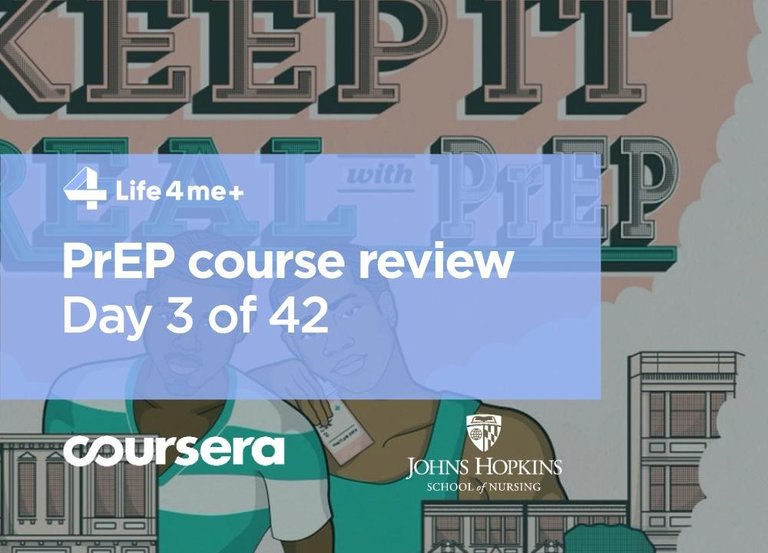
Today we will discuss the «State of Science» lecture of the first week of PrEParing online course. It was presented by Chris Beyrer, professor of epidemiology at Bloomberg School of Public Health at Johns Hopkins University.
The professor began the lecture with an overview of current recommendations. The recommendations of the World Health Organization (WHO), issued in September 2015, require the early start of antiretroviral therapy, immediately after the diagnosis of HIV infection, regardless of the number of CD4-lymphocytes (immune cells) in the patient’s blood. Let me kindly remind you that earlier recommendations were of the opinion that therapy should be started only after the CD4-cells depletion below a certain threshold.
Also, WHO now recommends providing PrEP in all populations with the prevalence of HIV infection above 3%. It means that if there is a city, province, state, country or region in which at least three people out of a hundred are carriers of HIV — in this region, it is advisable to prescribe PrEP to all HIV-negative people at risk.
What is a «risk group»?
The risk group includes:
- Gays, bisexuals and other men who have sex with men;
- Sex workers and sex workers of all gender identities;
- Transgender women who have sex with men and who are the most disproportionately burdened of any population worldwide;
- Women and girls in the southern and eastern African hyper-epidemic setting;
- Uninfected sexual partners of people living with HIV across all kinds of relationships, heterosexual, same sex, male, and trans;
- Adolescents from all the communities mentioned above, namely teenage boys who practice same-sex;
- Adolescent sex workers all genders and gender identities;
- Adolescents who inject drugs;
- Transgender adolescent women.
Before the PrEP providing has been initiated worldwide, many clinical studies were conducted, resulted in a bunch of meta-analyses and system reviews. Such reviews have shown a significant effect from providing PrEP in the absence of side effects or minor side effects from such practice.
Soon after, a series of demonstration projects of PrEP in 28 countries was conducted, summarizing the results of which researchers collaborating with ethics committees and regulatory state and international authorities had approved the practice of pre-exposure HIV infection prophylaxis (PrEP) with the daily intake of a single tablet.
At the moment, this tablet, as we mentioned in the previous article, is a combination of emtricitabine and tenofovir named ’Truvada’ manufactured by Gilead Sciences Truvada analogs are available in some countries in the form of an unoriginal, generic drug.
Since the approval for the use of the Truvada for PrEP, the massive growth of its use has begun. From 2012 to 2015, the consumption in the US market raised up to 738%, and currently, about 80 thousand people take Truvada every day as a PrEP in the US. After PrEP had begun to be applied, researchers from different universities continued to monitor risk groups. Such observations contributed to the updated recommendation of the WHO entitled «When to start antiretroviral therapy and PrEP» (2015), where PrEP was highly recommended as an additional approach to protect HIV transmission in risk groups. This recommendation is evidence-based.
Dr. Beyrer also talked about the studies of the PrEP effectiveness in cases of receptive anal intercourse events with condom and condomless.
«Do I need a condom in case a person takes PrEP? Is sex safe without a condom for two people living with HIV who have a virus in the blood suppressed by antiretroviral therapy and undetectable?»
If you are interested in these questions — try to watch the lectures yourself or ask questions in our Life4me+ group on Facebook.Prof.
Chris Beyrer also noted that a study conducted in 2014-2015 in the USA showed that the use of PrEP reduces anxiety, gives a sense of security during sex, reduces the stigma of HIV and promotes the formation of stronger relationships. Ultimately, PrEP gives to uninfected people control over the risk of getting HIV into their own hands, so they shouldn’t be worried about the partner: whether he/she is sincere, whether he/she receives adequate antiretroviral therapy, uses a condom or not.
In the future, the possibility of injectable and implantable PrEP is to be discovered, which possibly could allow the procedure to be performed once a week, a month or even once a year. Dr. Beyrer will continue his story tomorrow in the lecture «Demonstration Projects of PrEP.»
Stay with us; I will share the highlights of this speech tomorrow.
If you are interested in learning about PrEP more — sign up for the course at https://www.coursera.org/learn/prep
P. S. The original article was posted on the Life4me+ mobile app for HIV-positive persons blog.
Congratulations @franchb! You have completed some achievement on Steemit and have been rewarded with new badge(s) :
Click on any badge to view your own Board of Honnor on SteemitBoard.
For more information about SteemitBoard, click here
If you no longer want to receive notifications, reply to this comment with the word
STOPBy upvoting this notification, you can help all Steemit users. Learn how here!